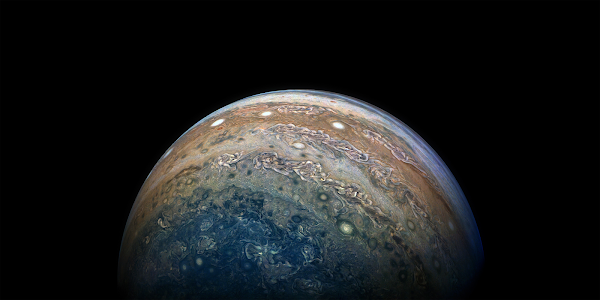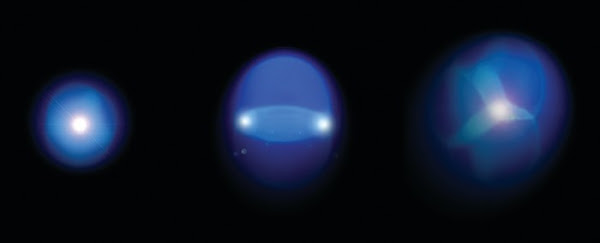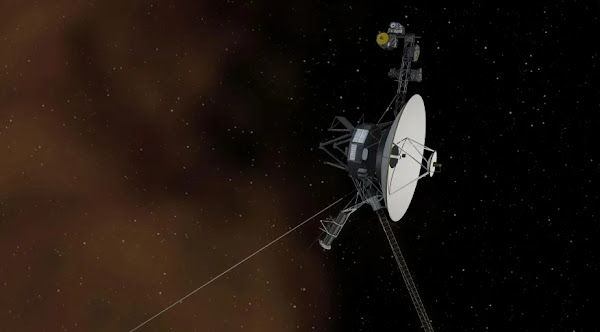segunda-feira, 31 de julho de 2023
Gravity
The theory of gravity was first formulated by Sir Isaac Newton in the late 17th century with his laws of motion and the law of universal gravitation. Newton's laws describe how objects move and accelerate under the influence of gravity, and the law of universal gravitation states that any two objects in the universe are attracted to each other with a force proportional to their masses and inversely proportional to the square of the distance between them.
However, Newton's laws were later modified by Albert Einstein's theory of general relativity, which describes gravity as a curvature of spacetime caused by the presence of mass or energy. This theory is supported by a wide range of experimental and observational evidence, including the observed orbits of planets, the bending of light around massive objects, and the existence of black holes.
Gravity plays a crucial role in the formation and evolution of the universe, from the formation of galaxies and stars to the formation of planetary systems. It also plays a fundamental role in the behavior of objects on different scales, from the motion of subatomic particles to the motion of galaxies.
Gravity also governs the motion of objects in our everyday lives, from the motion of projectiles to the motion of the planets and stars. It also has practical applications in areas such as navigation, geodesy, and earth science.
In summary, gravity is one of the fundamental forces of nature that governs the behavior of matter and energy in the universe. It is the force that attracts any two objects with mass towards each other. The theory of gravity was first formulated by Sir Isaac Newton in the late 17th century and later modified by Albert Einstein's
domingo, 30 de julho de 2023
Jupiter
The four most well-known moons of Jupiter are called the Galilean moons, because they were discovered by the Italian astronomer Galileo Galilei in 1610. These moons are Io, Europa, Ganymede, and Callisto.
Io is the innermost moon of Jupiter and is the largest volcanic moon in the solar system. The moon has active volcanoes and a thin atmosphere composed mainly of sulfur dioxide. Europa is the second closest Galilean moon to Jupiter and is known for its icy surface. It is believed that beneath this ice crust there is an ocean of liquid water, which has led many scientists to believe that there may be forms of life on the moon. Ganymede is the largest moon in the solar system and is known for its dense atmosphere and complex ring system. Callisto is the outermost of the four Galilean moons and is known for its dark surface and the presence of impact craters.
In addition to the Galilean moons, Jupiter has many other interesting and notable moons. The moon Himalia, for example, is one of the most distant moons from Jupiter and is known for its irregular shape. The moon Elara is known for its large impact crater and for being one of Jupiter's oldest moons I apologize, The moon Thebe is known for its proximity to the moon Io and for its surface covered with craters.
In summary, Jupiter's moons are an eclectic variety of celestial objects, each with its own unique and interesting characteristics. The four Galilean moons are the most well-known, but there are many other notable and interesting moons to be discovered and studied. The recent discovery of possible oceans beneath the ice crust on Europa has greatly increased scientific interest in the moon, and future missions will be planned to investigate this possibility.
sábado, 29 de julho de 2023
White Hole
They are formed when a star runs out of fuel and its outer layer is expelled, leaving only the dense core of the star. This core is compressed to such a point that protons and electrons combine to form neutrons.
White holes do not have a defined surface, they are simply a point of infinite density known as a singularity, where gravity is so intense that nothing, not even light, can escape.
Like black holes, white holes can also be detected through their gravitational influence on the matter around them. For example, they can be detected through their influence on nearby stars and planets. Additionally, they can also be detected through their influence on radiation, such as light.
In summary, white holes are dense stellar objects primarily composed of neutrons, it is the final remnant of the evolution of stars with mass smaller than stars that become black holes. They have masses comparable to that of the sun, but have smaller sizes than most planets. They are formed when a star runs out of fuel and its outer layer is expelled, leaving only the dense core of the star. White holes can be detected through their gravitational influence on the matter around them and their influence on radiation.
sexta-feira, 28 de julho de 2023
Electromagnetism
The theory of electromagnetism was first formulated by the scientist Michael Faraday in the early 19th century and later developed by James Clerk Maxwell in the mid-19th century. Maxwell's equations, a set of four differential equations, provide a mathematical framework for understanding the behavior of electric and magnetic fields and their interactions with charges.
One of the key concepts in electromagnetism is the electric charge. Electric charges can be either positive or negative, and they are the source of electric fields. Electric fields exert a force on other charges, and the strength of the force depends on the amount of charge and the distance between the charges.
Magnetic fields, on the other hand, are created by the motion of electric charges. This can be the motion of charges in an electric current, such as the flow of electrons in a wire, or the motion of charges in an atom. Magnetic fields exert a force on other charges that are moving, and this force is known as the Lorentz force.
The interaction of electric and magnetic fields is known as electromagnetic waves, which include radio waves, microwaves, infrared radiation, visible light, ultraviolet radiation, X-rays, and gamma rays. These waves are characterized by their wavelength and frequency, and they travel at the speed of light in a vacuum.
The electromagnetic force also plays an important role in many everyday applications, such as the generation and transmission of electricity, the operation of electric motors, and the operation of a wide range of electronic devices, from cell phones to televisions to computers.
In summary, electromagnetism is one of the fundamental forces of nature that governs the behavior of electric charges and the interactions between them. The theory of electromagnetism was first formulated in the early 19th century and provides a mathematical framework for understanding the behavior of electric and magnetic fields and their interactions with charges. The interaction of electric and magnetic fields produces electromagnetic waves and has many everyday applications in technology.
quinta-feira, 27 de julho de 2023
Life off Earth
The search for life off Earth is motivated by the discovery of many exoplanets, planets that orbit stars other than the Sun, and the realization that many of these exoplanets could potentially be hospitable to life. In recent years, scientists have discovered exoplanets that are located in the "habitable zone" of their star, which is the region where conditions are suitable for liquid water to exist.
Scientists are also studying the potential for life to exist in other forms, such as microbial life, in harsh environments on our own planet, such as deep beneath the Earth's surface or in extreme temperatures. These organisms provide clues about the types of environments that could potentially support life elsewhere in the universe.
In addition to the search for microbial life, scientists are also searching for evidence of advanced alien civilizations. This search involves the study of radio signals and other forms of electromagnetic radiation that could be produced by intelligent life. The search for extraterrestrial intelligence (SETI) is a field of research that is dedicated to this pursuit.
To search for life off Earth, scientists use a variety of tools, including telescopes, spacecraft, and robotic rovers. The search for life on Mars has been a major focus of recent missions, with NASA's Perseverance rover currently searching for signs of past microbial life on the Red Planet. Scientists are also planning future missions to explore the icy moons of Jupiter and Saturn, which are thought to have subsurface oceans that could potentially host life.
In summary, the search for life off Earth is the study of the potential for life to exist beyond our planet. This field of study draws on knowledge from a wide range of disciplines, including astronomy, biology, chemistry, and geology. Scientists are searching for evidence of microbial life as well as advanced alien civilizations. The search for life off Earth is motivated by the discovery of many exoplanets and the potential for them to be hospitable to life. The search for life off Earth is ongoing and uses a variety of tools, such as telescopes, spacecraft, and robotic rovers.
quarta-feira, 26 de julho de 2023
Strange Matter.
The theory of strange matter was first proposed in the 1970s, and since then, scientists have been trying to understand its properties and behavior. It is believed that strange matter could exist in the cores of neutron stars, where the immense pressure and temperature could force protons and neutrons to combine into strange matter.
Some scientists also theorize that strange matter could exist in the form of strangelets, which are small, dense, and stable particles composed of strange quarks. Some theories suggest that strangelets could be produced in high-energy collisions, such as those that occur in particle accelerators.
If strange matter exists, it could have some very unusual properties. For example, it could be much denser and more stable than regular matter, and it could be highly conductive to electricity. Strange matter could also be highly reactive, meaning it could potentially fuse with other forms of matter, including normal matter, which could lead to an unstable reaction called a "strangelet bomb."
The existence of strange matter has yet to be proven and its properties are not fully understood. Many scientists believe that it is possible that strange matter exists, but more research is needed to confirm this. The study of strange matter is an active area of research and is expected to continue to be an important area of study in the future.
In summary, strange matter is a hypothetical form of matter that is composed of up, down and strange quarks, it's called strange because the strange quarks have a property called "strangeness" that is different than the properties of the up and down quarks that make up the protons and neutrons in atoms that make up matter around us. The theory of strange matter was first proposed in the 1970s and scientists have been trying to understand its properties and behavior. The existence of strange matter
has yet to be proven and its properties are not fully understood. However, it's believed that strange matter could exist in the cores of neutron stars and in the form of strangelets, which are small, dense, and stable particles composed of strange quarks.
If strange matter exists, it could have some very unusual properties, such as being much denser and more stable than regular matter, and it could be highly conductive to electricity. The study of strange matter is an active area of research and is expected to continue to be an important area of study in the future, as scientists continue to explore the properties of this mysterious and intriguing form of matter.
terça-feira, 25 de julho de 2023
Starship
Space exploration has always fascinated humanity, and technological advancements have allowed dreams once considered impossible to become a reality. A notable example is the Starship, a spacecraft developed by SpaceX, led by visionary Elon Musk. In this article, we will explore the journey of the Starship, from its conception to the latest official updates, highlighting its importance and impact on the future of space exploration.
Conception and Initial Idea
The idea of creating a fully reusable spacecraft was the driving force behind the Starship project. SpaceX recognized the need for more advanced technology to significantly reduce launch costs and make space exploration more accessible. Elon Musk first announced plans for the Starship in 2016, with the goal of creating a spacecraft capable of carrying cargo and passengers to destinations beyond Earth, including the Moon, Mars, and beyond.
Development and Testing
The development of the Starship involved a series of iterations and intensive testing. SpaceX adopted an iterative approach, learning from each prototype version. The initial flight tests were conducted with prototypes called "Starhopper" and "SN5" and were instrumental in the development and refinement of the spacecraft's design
In May 2021, a significant milestone was achieved when the Starship prototype SN15 successfully performed a suborbital flight and landed safely, demonstrating the potential of controlled landing and reuse technology.
Features and Capabilities
The Starship is designed to be a high-capacity and versatile spacecraft. With a height of approximately 50 meters and a diameter of 9 meters, it has the ability to transport up to 100 passengers or a substantial payload to interplanetary destinations.
One of the key features of the Starship is its reusability. Unlike traditional disposable spacecraft, the Starship is designed to land and be reused for multiple missions. This revolutionary approach has the potential to significantly reduce the costs associated with space travel and pave the way for more sustainable space exploration.
Latest Official Updates
SpaceX continues to enhance and refine the Starship. An important update was the introduction of the Raptor propulsion system, a highly efficient rocket engine that powers the spacecraft. Additionally, the company has conducted pressurization and cryogenic tests, essential to ensure the structural integrity and functionality of the Starship in extreme space environments.
As the development of the Starship progresses, SpaceX envisions a future where it will play a vital role in various missions, including lunar landings and the eventual colonization of Mars. With its ambitious goals and continuous improvements, the Starship represents a significant step forward in advancing space exploration and realizing humanity's dreams of venturing beyond our home planet.
Conclusion
The Starship is a remarkable achievement in the field of space exploration. Its reusable design, advanced capabilities, and ongoing developments by SpaceX demonstrate a commitment to revolutionizing space travel and expanding the boundaries of human exploration. With the potential to make space more accessible and sustainable, the Starship holds great promise for the future of space exploration and the realization of our cosmic aspirations.
segunda-feira, 24 de julho de 2023
Unveiling the Secrets of Deep Space: Exploring the Discovery of Deep Space
Introduction:
The exploration of deep space has been a fascinating endeavor that has allowed us to expand our knowledge and understanding of the universe. In this article, we will delve into the exciting journey of discovering deep space, from early observations and theories to groundbreaking discoveries and advancements in technology that have revolutionized our understanding of the cosmos.
Early Observations and Theories:
Throughout history, humans have gazed up at the night sky, observing the stars and wondering about the vastness beyond. Early civilizations developed myths and legends to explain the celestial bodies they saw. However, it was not until the development of telescopes in the 17th century that astronomers began to make significant observations and formulate theories about the nature of deep space. Pioneers like Galileo Galilei and Johannes Kepler made important contributions, paving the way for future explorations.
Revolutionary Discoveries:
In the early 20th century, groundbreaking discoveries reshaped our understanding of deep space. Edwin Hubble's observations using the powerful Hooker Telescope revealed that the universe is expanding, leading to the formulation of the Big Bang theory. This theory suggests that the universe originated from a single point of immense energy and has been expanding ever since. Hubble's work also demonstrated the existence of other galaxies beyond our Milky Way, revealing the vastness of deep space.
Technological Advancements:
Advancements in technology have played a pivotal role in our ability to explore deep space. Telescopes equipped with advanced optics, such as the Hubble Space Telescope, have provided stunning images of distant galaxies, nebulae, and other celestial objects. Space missions, such as the Voyager and Cassini missions, have allowed us to study and gather data about distant planets, moons, and even interstellar space. Furthermore, the development of powerful computers and data analysis techniques has enabled scientists to process and interpret vast amounts of astronomical data, uncovering new insights into deep space.
Understanding the Cosmos:
The exploration of deep space has provided us with valuable knowledge about the formation and evolution of galaxies, the existence of black holes, the nature of dark matter and dark energy, and the possibilities of extraterrestrial life. It has also allowed us to study phenomena such as supernovae, pulsars, and gravitational waves, contributing to our understanding of the fundamental laws that govern the universe.
Future Prospects:
As technology continues to advance, our ability to explore deep space will only expand. Missions to Mars and other planets, as well as the development of advanced telescopes and space observatories, will provide us with even more detailed information about the mysteries of deep space. Additionally, collaborations between space agencies and international organizations allow for shared knowledge and resources, furthering our collective understanding of the cosmos.
Conclusion:
The discovery of deep space has been a remarkable journey of human curiosity, innovation, and scientific exploration. From ancient civilizations peering into the night sky to the cutting-edge technology of today, we have made tremendous strides in unraveling the mysteries of the universe. The exploration of deep space continues to captivate our imaginations and push the boundaries of human knowledge, reminding us of the limitless possibilities that lie beyond our home planet.
domingo, 23 de julho de 2023
The Voyagers: Humanity's Enduring Messengers in Deep Space
The Voyagers are celestial pioneers, embarking on an odyssey through the outer realms of our solar system and beyond. They have rewritten the textbooks of planetary science, gifted us awe-inspiring images, and carried humanity's greetings into the depths of interstellar space. As these intrepid probes continue their cosmic voyage, they remind us of the boundless potential of human exploration and the enduring spirit of discovery that drives us to explore the unknown.
Introduction:
The Voyager spacecraft, comprising Voyager 1 and Voyager 2, are iconic representatives of human exploration beyond the confines of our home planet. Launched in 1977, these interstellar emissaries have embarked on an incredible journey through our solar system and continue to push the boundaries of human knowledge. In this article, we will delve into the remarkable story of the Voyagers, their scientific accomplishments, and their enduring legacy in the annals of space exploration.
Unveiling the Unknown:
The primary mission of the Voyager spacecraft was to study the outer planets of our solar system, including Jupiter, Saturn, Uranus, and Neptune. Equipped with an array of scientific instruments, these probes unveiled a multitude of discoveries that revolutionized our understanding of these distant worlds. They captured breathtaking images of Jupiter's turbulent atmosphere, unveiled the intricacies of Saturn's rings, discovered active volcanoes on Jupiter's moon Io, and revealed the intricate details of Neptune's Great Dark Spot, among countless other findings.
A Grand Tour:
The Voyagers' trajectory allowed them to conduct a "Grand Tour" of the outer planets, taking advantage of a rare alignment that occurs only once every 175 years. This fortuitous alignment enabled the spacecraft to harness the gravitational assists of each planet, propelling them from one destination to the next. This unprecedented journey provided a wealth of scientific data and insights into the diverse and dynamic nature of our celestial neighbors.
Beyond the Planets:
While the Voyager missions initially focused on the outer planets, their incredible resilience and longevity allowed them to venture into interstellar space, far beyond the influence of the Sun. Voyager 1 achieved this milestone in 2012, followed by Voyager 2 in 2018. These historic achievements marked the first human-made objects to reach the realm between the stars, carrying with them humanity's message to potential extraterrestrial civilizations.
Golden Records:
One of the most captivating aspects of the Voyager spacecraft is the inclusion of the "Golden Record." Affixed to each probe is a gold-plated copper phonograph record containing a selection of sounds, images, and greetings from Earth. Curated by a team led by astronomer Carl Sagan, this time capsule encapsulates the diversity of human culture and serves as a testament to our curiosity and desire to connect with the unknown.
Endurance and Future:
Despite being launched over four decades ago, the Voyagers continue to operate and transmit data back to Earth. Their longevity can be attributed to their radioisotope thermoelectric generators (RTGs), which provide the necessary power for essential systems and instruments. While their power output diminishes over time, the Voyagers are expected to continue communicating with Earth until around 2025, providing valuable insights into the uncharted territories of interstellar space.
Legacy and Inspiration:
The Voyagers stand as enduring symbols of human ingenuity and determination to explore the cosmos. They have provided invaluable scientific knowledge, captured the imagination of millions, and redefined our place in the universe. Their success has paved the way for subsequent missions, such as New Horizons, and continues to inspire future generations of scientists, engineers, and space enthusiasts to push the boundaries of what is possible.
sábado, 22 de julho de 2023
The Higgs Boson: Unveiling the Particle that Shaped the Universe
Introduction:
The discovery of the Higgs boson stands as one of the most significant achievements in the field of particle physics. Known as the "God particle," the Higgs boson provides insight into the fundamental nature of the universe and the origin of mass. In this article, we will delve into the intriguing world of the Higgs boson, its theoretical foundation, the experimental hunt for its existence, and its profound implications for our understanding of the cosmos.
Theoretical Foundations:
The concept of the Higgs boson originates from the Higgs field, an invisible energy field that permeates the entire universe. According to the Standard Model of particle physics, particles gain mass by interacting with the Higgs field, akin to wading through a dense medium. The Higgs boson, postulated by physicists Peter Higgs and François Englert in the 1960s, is the quantum excitation of this field and its detection was crucial for validating this theory.
Experimental Quest:
The search for the Higgs boson demanded the construction of the world's most powerful particle accelerator, the Large Hadron Collider (LHC) at CERN. With its colossal energy and precision, the LHC allowed scientists to recreate conditions similar to those just after the Big Bang. By colliding protons at high speeds, researchers aimed to produce Higgs bosons, which would quickly decay into other particles that could be detected by intricate detectors surrounding the collision points.
Discovery and Significance:
On July 4, 2012, the ATLAS and CMS collaborations at the LHC jointly announced the discovery of a new particle consistent with the Higgs boson. This groundbreaking finding confirmed the existence of the Higgs field and unlocked a new realm of understanding in particle physics. The discovery not only validated the Standard Model but also provided a missing piece of the cosmic puzzle, shedding light on the fundamental nature of mass and the origin of the universe.
Implications and Future Research:
The discovery of the Higgs boson has far-reaching implications for both theoretical physics and cosmology. It deepens our understanding of the fundamental forces that govern the universe and provides a basis for further exploration into unanswered questions, such as the nature of dark matter and the unification of all fundamental forces. Ongoing research aims to precisely measure the properties and interactions of the Higgs boson, probing its role in the cosmos and potentially uncovering new physics beyond the Standard Model.
Conclusion:
The Higgs boson represents a monumental milestone in human scientific achievement. Its discovery not only confirms our understanding of the universe at its most fundamental level but also fuels the pursuit of knowledge, pushing the boundaries of human curiosity and technological capabilities. The Higgs boson stands as a testament to the collective efforts of scientists worldwide, showcasing the power of human intellect and our relentless quest to unravel the mysteries of the cosmos.
Several Fundamental
There are laws of the universe that govern physics and chemistry, but some of the main ones include: Isaac Newton's Law of Gravity: thi...

-
There are laws of the universe that govern physics and chemistry, but some of the main ones include: Isaac Newton's Law of Gravity: thi...
-
Space exploration has always fascinated humanity, and technological advancements have allowed dreams once considered impossible to become a ...
-
The evolution of the solar system is the story of how the sun and its planets formed and developed over time. The process began around 4.6 b...















